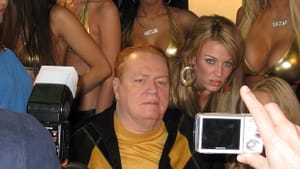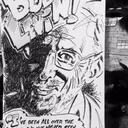Stay in the Loop
BSR publishes on a weekly schedule, with an email newsletter every Wednesday and Thursday morning. There’s no paywall, and subscribing is always free.
The archduke and the pervert
Dwaine Tinsley and the vagaries of history

In 2005, five years after his death from a heart attack in his Simi Valley living room, I decided to write about Dwaine Tinsley. The idea came from an editor who knew my interest in unusual cartoonists — Tinsley was as unusual as they came. The child of trailer trash parents, a junkie-burglar, he had reinvented himself in prison by deciding to pursue an artistic vision. This quest led him to a publisher of similar outlaw background and fuck-the-establishment orientation, and soon Tinsley was chief cartoonist for Hustler magazine, the flagship publication of Larry Flynt.
Tinsley’s primary contribution was a monthly gag cartoon, Chester the Molester, about a hulking, middle-aged man interested in prepubescent girls. Chester ran from 1976 until 1989, when Tinsley’s teenage daughter accused him of sexual abuse. Tinsley denied all charges, attributing them to her resentment of his having kicked her out of the family home because of cocaine addiction.
My book was welcomed by Dwaine’s widow, Ellen, who believed in his innocence, wanted his story told, and had failed to interest other writers in it. She also hoped to create a market for Dwaine’s cartoons, whose rights she owned. Most Outrageous, while greeted with fine reviews, failed to earn enough to cover my research costs — or to raise Dwaine’s market share. But, hell, I didn't write it for the money. I represented the injured in workers’ compensation claims for that. And one night, in the midst of my writing, I had awoken thinking, Maybe Ellen has a claim for Dwaine’s death.
Cause and effect
Under California law, if work stress had contributed to Dwaine’s death, Ellen could receive $125,000, which was a lot of sold cartoons. Ellen believed that stress had done Dwaine in and did not mind suing Larry Flynt to prove it. But I hoped to interview Flynt and did not believe my name on pleadings would help my chances, so I found her another lawyer. He had never tried a death case and, despite this one’s major problems, wanted the experience. But one evening, a disgruntled former client walked into his office and shot and killed him. Ellen’s file sat in a storage box until a probate attorney spotted my name in some correspondence and asked me to take it on.
By now, the book was out. Larry Flynt had ignored me. “Sure,” I said.
My first problem was finding a doctor to testify that, despite Dwaine’s less than stress-free life, work had contributed to his fatal heart attack. I believed I could, but I was positive that Larry Flynt Publications could find one to conclude the opposite.
The bigger problem was the statute of limitations. For a death to be compensable, it must occur within 240 weeks of the injury, which, in case of cumulative trauma, is usually the last day of injurious exposure. And Ellen’s claim had come nearly five years since Dwaine had worked.
I found a doctor who established causation. And LFP was so certain of its statute of limitations defense it didn't obtain an expert opinion to counter him. Their cost-consciousness approach seemed validated when the assigned judge urged me to accept a nuisance value settlement and, when I refused, glared at me like I had drowned her kitten. But I had done my research, and I believed I had a crevice in the law through which to slip, one that would prevail on appeal.
The case went on...and on...and on. Then it settled for 40 times what the judge had recommended. We could have had more, but Ellen, in ill health, insisted.
What if?
 At the seder, my brother-in-law, the retired historian, said if he could return in time, empowered to take one action, he would give Archduke Ferdinand’s chauffeur proper directions. It seems those plotting to assassinate the archduke, whose murder led to the outbreak of World War I, had given up awaiting his arrival and were headed home, when the chauffeur’s wrong turn brought him abreast of a departing killer. “No World War I,” my brother-in-law said, “no Bolshevik revolution, no Hitler, no Holocaust, no 20th century as we know it.”
At the seder, my brother-in-law, the retired historian, said if he could return in time, empowered to take one action, he would give Archduke Ferdinand’s chauffeur proper directions. It seems those plotting to assassinate the archduke, whose murder led to the outbreak of World War I, had given up awaiting his arrival and were headed home, when the chauffeur’s wrong turn brought him abreast of a departing killer. “No World War I,” my brother-in-law said, “no Bolshevik revolution, no Hitler, no Holocaust, no 20th century as we know it.”
"But," said Richard, the art critic, "so many sparks lay about waiting to ignite that war was inevitable." "But how soon?" my brother-in-law said. "After what intervening events, making which things better and which worse?"
I stand with him. History is nothing but the intersection of zillions of lives, altering or capable of being altered any moment by the others in which they are engulfed. If I was not a writer with my peculiar interests; if I had not practiced workers’ compensation law; if that client had not become disgruntled. . . .The world spins; people are thrown about. We collide and collide. Sparks fly. Fires burn. But different and unpredictable are their incinerations, their heat and paths of scorching.
Sign up for our newsletter
All of the week's new articles, all in one place. Sign up for the free weekly BSR newsletters, and don't miss a conversation.
 Bob Levin
Bob Levin